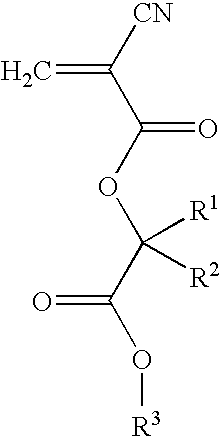Cyanoacrylate compositions containing anti-microbial agent
a technology of cyanoacrylate and anti-microbial agent, which is applied in the direction of drug compositions, surgical adhesives, dressings, etc., can solve the problems of difficult sterilization of -cyanoacrylate adhesive compositions, contamination of compositions, and insoluble iodine/polymer complexes in cyanoacrylate ester, etc., to achieve complete solubility and extend utility
- Summary
- Abstract
- Description
- Claims
- Application Information
AI Technical Summary
Benefits of technology
Problems solved by technology
Method used
Image
Examples
example 1
A 2-octyl cyanoacrylate monomer composition is prepared by adding 1 wt % triclosan to 2 mL of 2-octyl cyanoacrylate monomer. The mixture is sealed in a glass vial or plastic vial and stirred.
The characteristics of the composition are observed at about one minute after preparation and later at least twenty-four hours after preparation. The results of the observations show that the solution remains clear, indicating that triclosan is soluble in the monomer and does not cause premature polymerization.
example 2
A 2-octyl cyanoacrylate monomer composition is prepared as in Example 1 by adding 1 wt % triclosan to 2 mL of 2-octyl cyanoacrylate monomer. The mixture is sealed in a glass vial or plastic vial and stirred.
After sitting for about twenty-four hours, the mixture contained in the plastic vial is sterilized using electron beam sterilization to a Sterility Assurance Level (SAL) of 10−6. After sitting for about twenty-four hours, the mixture contained in the glass vial is sterilized using dry heat sterilization to a Sterility Assurance Level (SAL) of 10−6. The characteristics of the sterilized compositions are observed at about one minute after sterilization and later at least twenty-four hours after sterilization. The results of the observations show that the solutions remains clear, indicating that triclosan is compatible with electron beam sterilization and dry heat sterilization processing and does not cause premature polymerization during or after sterilization.
PUM
| Property | Measurement | Unit |
|---|---|---|
| Time | aaaaa | aaaaa |
| Time | aaaaa | aaaaa |
| Time | aaaaa | aaaaa |
Abstract
Description
Claims
Application Information
 Login to View More
Login to View More - R&D
- Intellectual Property
- Life Sciences
- Materials
- Tech Scout
- Unparalleled Data Quality
- Higher Quality Content
- 60% Fewer Hallucinations
Browse by: Latest US Patents, China's latest patents, Technical Efficacy Thesaurus, Application Domain, Technology Topic, Popular Technical Reports.
© 2025 PatSnap. All rights reserved.Legal|Privacy policy|Modern Slavery Act Transparency Statement|Sitemap|About US| Contact US: help@patsnap.com

